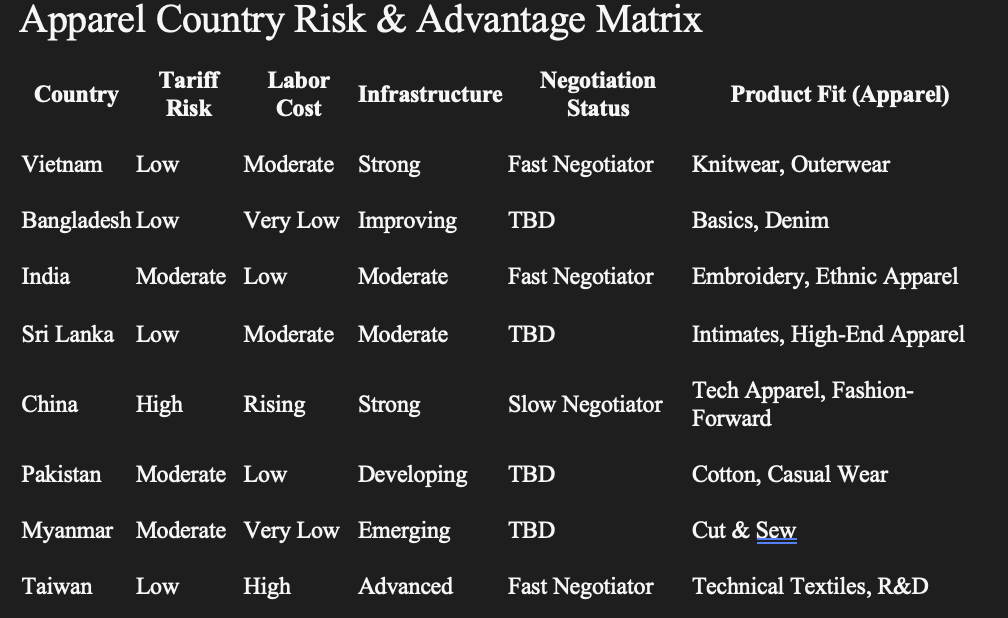Navigating the Apparel Supply Chain After U.S. Tariff Talks: A New Global Playbook
The Trump Tariff Era: A Disruption Tailored to Apparel
Few industries felt the sting of U.S. tariff policies under the Trump administration as acutely as apparel. With margins already compressed and lead times growing shorter, apparel brands and retailers had little room to absorb sudden cost hikes. Yet, as the tariff landscape begins to stabilize through selective negotiations, the industry is finding new opportunities embedded within the disruption.
What’s emerging is not just a reallocation of sourcing—but a long-term strategic rethinking of global supply chain networks.
Countries have responded differently to the Trump administration’s aggressive trade policy, and apparel companies are recalibrating sourcing strategies accordingly.
Fast Negotiators (Agile Apparel Allies):
Vietnam: With strong manufacturing infrastructure and a pro-trade government, Vietnam has quickly moved to negotiate.
Cambodia, India, Taiwan, and Japan have followed suit: These countries have shown eagerness to negotiate favorable terms, offering competitive labor costs and specialization in textiles, embroidery, and niche production.
Slow Negotiators (Strategic but Stalled):
China: Still indispensable for high-volume, technically complex apparel (e.g., performance wear, fashion-forward SKUs), but long-term uncertainties due to geopolitics and slower trade negotiations push brands to adopt a “China+1” approach.
The Emerging Status Quo in Apparel
We’re entering a new chapter where not all sourcing partners are treated alike—but each finds a path toward equilibrium.
Key Trends in Apparel Supply Chains:
Regional Diversification: Instead of relying on one dominant supplier, brands now spread sourcing across several countries to hedge against tariff and logistics risk.
Specialization of Supply: Countries are becoming known for product types—e.g., Bangladesh for denim and basics, Vietnam for outerwear and sportswear, Sri Lanka for high-end intimates.
Reinvestment in Agility: Retailers are adopting modular manufacturing, nearshoring for speed to market, and investing in data-driven demand forecasting to offset slower lead times in diversified supply chains.
Strategic Takeaways for Apparel Leaders
Redesign the Sourcing Mix: Use a tiered approach—core volume in Bangladesh/Vietnam/Pakistan, value-add in Sri Lanka/Taiwan, strategic hold in China.
Accelerate Nearshoring: Consider nearshoring in Central America to balance out Asia-centric sourcing.
Double Down on Compliance: Countries with strong labor and environmental practices will have longer-term competitive advantage in future trade deals.
Build End-to-End Flexibility: Retailers must integrate supply chain, design, and inventory teams to enable rapid pivots in production and distribution.
Conclusion: Fashioning a Resilient Future
The Trump administration’s tariff shock may have upended old norms, but it’s created an opportunity to catalyze a smarter, more resilient apparel supply chain. As more countries negotiate toward a stable trade relationship with the U.S., the brands that will thrive are those willing to embrace a global, dynamic, and diversified sourcing strategy.
Useful Links for Further Reading
• https://www.nytimes.com/2025/04/06/world/europe/trade-trump-tariffs-brexit.html
• https://www.dw.com/en/trump-tariffs-50-nations-seek-new-us-trade-talks/live-72156081
• https://www.nbcnews.com/business/business-news/us-stock-futures-plunge-ahead-monday-open-trump-tariffs-shock-continue-rcna199924
• https://www.bbc.com/news/articles/c2093qgx14po
• https://www.usatoday.com/story/money/2025/04/06/trump-tarriff-impact/82964313007/
• https://www.cnn.com/politics/live-news/trump-tariffs-news-04-06-25/index.html
• https://apnews.com/article/trump-tariffs-recession-financial-markets-negotiations-retaliation-860760cdc1aa2cc58853c9aab987e36d
• https://www.whitehouse.gov/presidential-actions/2025/04/regulating-imports-with-a-reciprocal-tariff-to-rectify-trade-practices-that-contribute-to-large-and-persistent-annual-united-states-goods-trade-deficits/
• https://www.theguardian.com/us-news/2025/apr/06/trump-tariffs-administration-reacts

